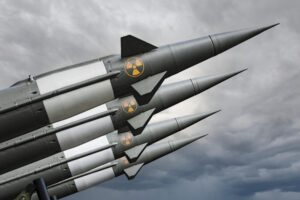The semiconductor industry, an unglamourous and largely anonymous field, is enjoying a rare moment in the sun. Thanks to supply shortages and the U.S. government’s belated realization of the role semiconductors play in weapons systems and elsewhere, congressional leaders and the Biden administration are committing taxpayers to spending billions on domestic chip factories.
It’s been a long time coming. Some decades ago, I met the late founder of Linear Integrated Systems, John H. Hall, after he came to Washington, D.C., to testify on the dangers posed to the U.S. military industrial base by the 1980s trend of semiconductor companies moving fabrication overseas. Hall was one of the founders of Silicon Valley, a protégé of Jean Hoerni who also occasionally worked with Nobel Prize winner Bill Shockley. Hall’s first fabrication facility built in Mountain View for Union Carbide in 1962, later became Intel’s first fabrication facility.
Testifying at a 1988 Senate hearing, Hall warned that Japanese investment in U.S. companies was resulting is critical semiconductor technology being exported to Japan and then re-exported to China’s low-cost production facilities. Hall recounted his first-hand experience. His previous company, Micro Power Systems, had been a joint venture with Seiko. When Seiko took over the company, the technology to build chips for multiple U.S. weapons systems ended up in the Chinese semiconductor ecosystem. He rightly predicted the Pentagon would become highly dependent on foreign suppliers.
I worked with Hall closely over the years, and when he passed away in 2014, I became president of Linear Systems, by which time the predictions he’d made before Congress had largely come true. Ambitious business leaders, competent engineers and friendly operating environments combined to make overseas semiconductor companies highly competitive and successful. The U.S. share of semiconductor manufacturing fell from 37 percent in 1990 to 12 percent today, according to the Semiconductor Industry Association.
The U.S. government’s ability to steer the destiny of the semiconductor industry has declined as well. The Defense Department has gone from being the dominant semiconductor customer in the 1950s and 1960s to a very minor one with little ability to influence corporate decisions. In fact, only a tiny fraction of production from the proposed new U.S. plants, something approaching a rounding error, will go into critical U.S. weapons systems.
Not surprisingly, the argument that we need domestic semiconductor manufacturing to supply defense needs overlaps with a national competitiveness argument that we need an invigorated chip industry as a key part of our economy.
Acknowledging these imperatives, President Biden recently signed into law the Creating Helpful Incentives to Produce Semiconductors (CHIPS) for America Act. Tax breaks, loans and direct subsidies are on the short list of tools the government has for boosting the semiconductor industry’s fortunes in the next three to five years. The CHIPS legislation shows the U.S. government has learned something from previous efforts like the Solyndra debacle, as it’s now focusing on proven technologies, but the devil is always in the implementation details.
Simply encouraging more modern semiconductor fabrication facilities in the U.S. isn’t enough to ensure a secure source of chips
What CHIPs fails to account for is the damage already done to the industry. The entire ecosystem needed to produce components ready to install on circuit boards for everything from weapons systems to automobiles has been ravaged for years by overseas competition, poor corporate management, boom/bust sales cycles and necessary, increasingly hard-to-meet environment laws and regulations.
Another reality CHIPS neglects is the fact that spare parts for most fabrication production equipment must cross large bodies of water to get to us. The base of semiconductor support vendors has declined in lockstep with the loss of domestic fabrication facilities but has remained outside the current debate over the health of the industry.
For our part, Linear Systems ensures its ability to provide components for customers by dividing its production among three Silicon Valley fabrication facilities. This has allowed us to meet the needs of the Defense Department as well as sensor, test/measurement and audio companies around the world. Despite the problems created by just-in-time sourcing of components, we’ve always kept on hand buffer stocks of production supplies and built large supplies of wafers in anticipation of future orders. For many of the high-performance, small-signal, discrete components we make, we’re the sole supplier — and we take that responsibility seriously.
A thin and scattered industrial base threatens production
But our approach no longer provides the level of production stability it did even recently. Key supplies and services required to deliver finished products come from an increasingly thin and scattered industrial base. Suppliers are warning of shortages, rationing and allocations. Production stops when any one key item is missing.
A prime example is the fact that most of the world’s supply of industrial-grade neon, an essential input for semiconductor fabrication, along with other industrial gases, comes from Ukraine. This supply is threatened now and for the foreseeable future.
The fact is, critical chemicals used in semiconductor production come from a very small list of suppliers, almost all of which are located outside the U.S.
It’s not just chemicals, it’s processes. Finished wafers must be cut into individual die, a precise and complex process, and I can count the number of companies available to do that for us on one hand, with fingers left over. Having world-class fabs without the materials and services needed to make semiconductors would be analogous to our current problem with car factories lacking parts to deliver vehicles.
Some are paying attention to these crucial details. The National Defense Industrial Association and other organizations have done good work assessing the viability of the defense industrial base, but a more granular examination of the semiconductor ecosystem is needed for national security and overall economic reasons.
Members of Congress seeking to ensure robust domestic fabrication would benefit from a more complete and accurate appraisal of why the overall industrial base has declined so much and what might still be missing after they invest billions.







